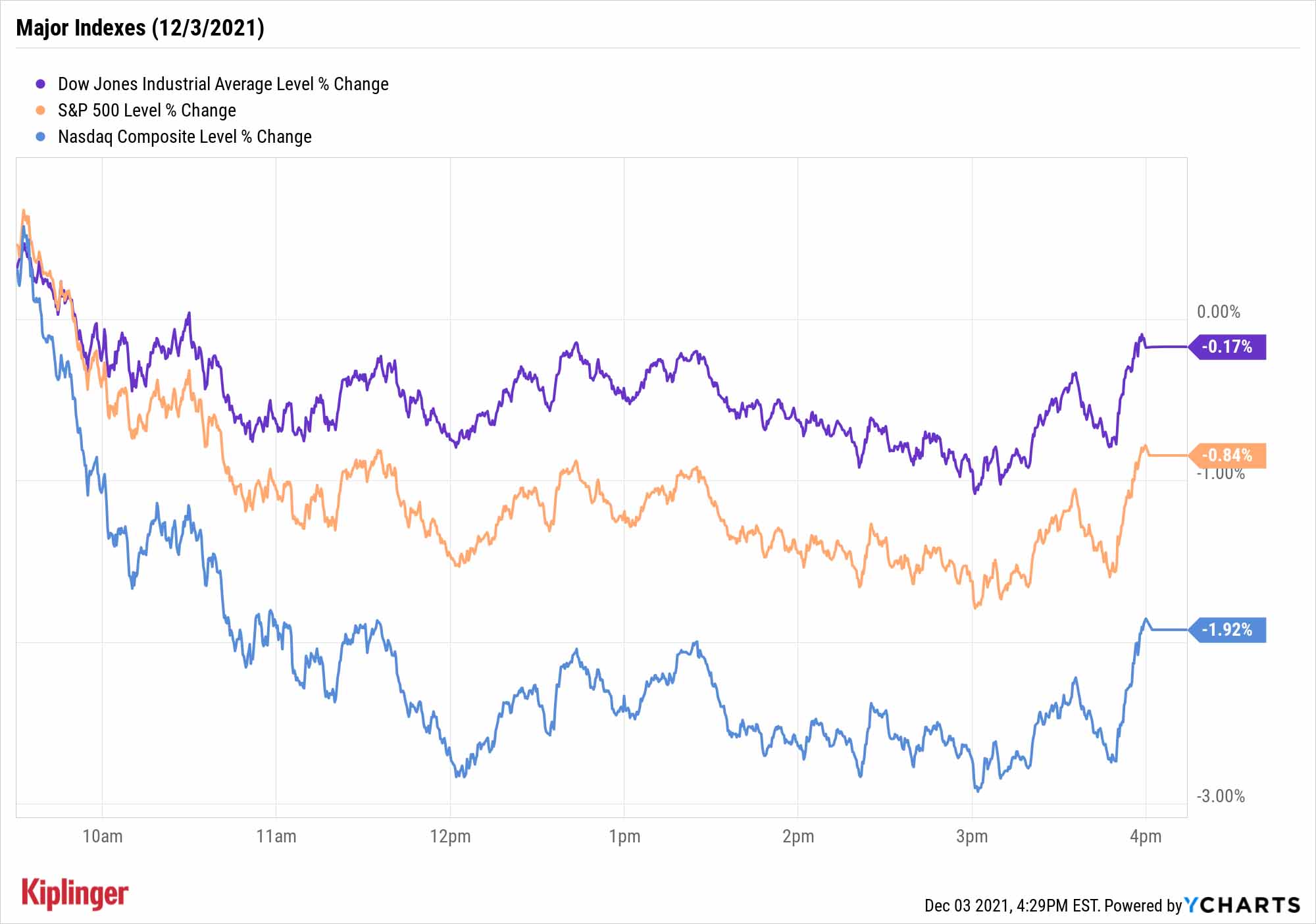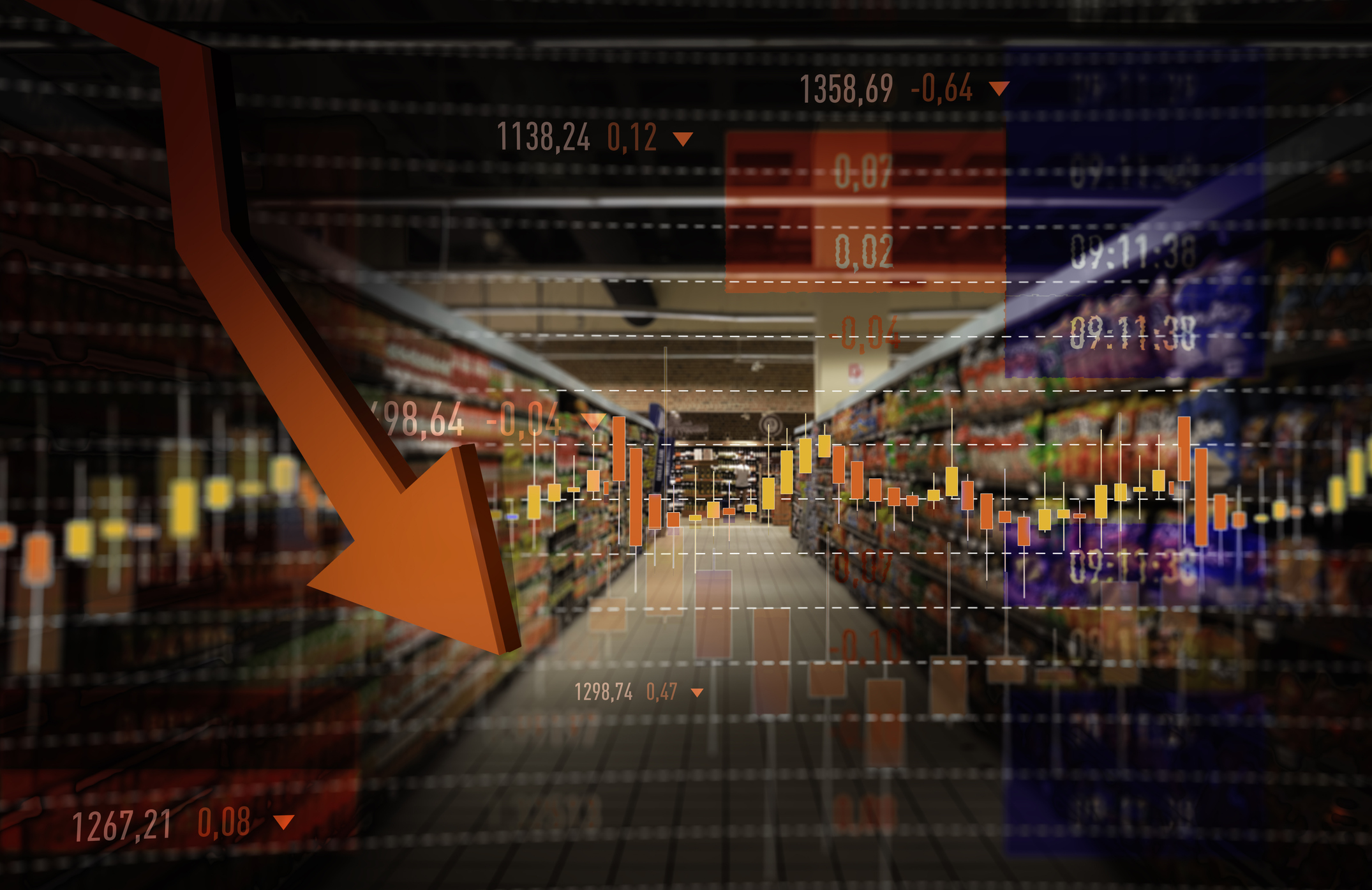Stock Market Today: Stocks Turn Tail Amid November Jobs Miss, Omicron
Wall Street capped off an omicron-inspired zigzag week of trading with a dip after November's headline jobs figure came up short.


At least momentarily, a mixed November jobs report seemed likelier to lift the market than weigh it down, but that promise quickly vanished Friday as the major indexes slid into the red.
Ahead of the open, the Bureau of Labor Statistics reported that just 210,000 nonfarm jobs were created last month, well shy of estimates for 573,000. Despite that lousy headline showing, some experts pointed to substantive strength elsewhere in the report.
"The unemployment rate dropped to 4.2% – the lowest since February 2020 – and is getting very close to pre-pandemic levels," says Robert Conzo, CEO of registered investment advisory The Wealth Alliance. "In addition, the participation rate (the share of people working or looking for work) rose, which is a good sign for the economy."

Sign up for Kiplinger’s Free E-Newsletters
Profit and prosper with the best of expert advice on investing, taxes, retirement, personal finance and more - straight to your e-mail.
Profit and prosper with the best of expert advice - straight to your e-mail.
Rick Rieder, BlackRock's chief investment officer of global fixed income, points out a couple other encouraging stats. For one, hourly wages jumped 4.80% year-over-year and 0.26% month-over-month, "providing a strong incentive for workers to return to the labor force." And the six-month average for non-seasonally adjusted private payroll gains is an impressive 700,000-plus jobs.
"We currently sit at 97.7% of the pre-COVID (February 2020) level of private employment," he adds. "In many respects, the job market right now is very strong."
Among the labor market's weak spots were leisure, hospitality and retail, which Anu Gaggar, global investment strategist for Commonwealth Financial Network, chalked up to online holiday shopping and, in some states, the winter virus surge.
"As the omicron variant starts to spread, labor force growth in these sectors could remain under pressure," he says.
Ultimately, however, the November jobs report's positives weren't enough to outweigh the negatives for investors, who also saw the COVID-19 omicron variant spreading domestically, with five states recording cases as of Thursday night.
The Dow Jones Industrial Average gained as much as 161 points early on before swinging to a 375-point decline at its nadir; a late-afternoon rally limited its losses to 59 points, or -0.2% to 34,580. The S&P 500 (-0.8% to 4,538) and Nasdaq Composite (-1.9% to 15,085) also flipped from green to red and sustained deeper losses.

Other news in the stock market today:
- The small-cap Russell 2000 sank 2.1% to 2,161.
- U.S. crude futures ended the day down 0.4% at $66.26 per barrel. For the week, oil prices were down 2.8%, marking their sixth straight weekly decline – the longest such streak since November 2018.
Gold futures gained 1.2% to settle at $1,783.90 per ounce. Week-over-week, gold ended marginally lower. - Bitcoin wasn't immune to Friday's weakness, slumping 6.2% to $53,494.33. (Bitcoin trades 24 hours a day; prices reported here are as of 4 p.m.)
- It was a cringe-worthy session for DocuSign (DOCU), which plunged 42.2% after earnings – its biggest single-day drop ever. While the electronic signature company reported adjusted earnings of 58 cents per share on $545.5 million in revenue – more than the 46 cents per share and $531 million analysts were expecting – it forecast fourth-quarter revenue below the consensus estimate and year-over-year growth of 30%, slower than the 40% sales growth it has seen in each of the last six quarters. "While we had expected an eventual step down from the peak levels of growth achieved during the height of the pandemic, the environment shifted more quickly than we anticipated," said CEO Dan Springer in the earnings call. In response, Needham analyst Scott Berg downgraded DOCU to Hold from Buy, expecting it to take time for the company to adjust to sales changes.
- Chinese stocks took it on the chin today. As explained in today's free A Step Ahead e-newsletter, Beijing-based ride-hailing firm Didi Chuxing (DIDI, -22.2%) said it is taking immediate steps to delist from the New York Stock Exchange (NYSE). This sparked uncertainty over other Chinese stocks that remain listed in the U.S., including e-commerce giant Alibaba Group (BABA), which saw its shares slide 8.2%. JD.com (JD, -7.7%), Baidu (BIDU, -7.8%) and Pinduoduo (PDD, -8.2%) were among some of the other notable decliners.
- Toll Brothers (TOL), GameStop (GME) and Costco (COST) headline a light earnings calendar next week.
Virus Uncertainty Looms Over the Market
Not sure what to think about the omicron variant's effects on markets after a week of stocks teeter-tottering? You're not alone – the pros haven't quite made up their minds either.
"We are still awaiting more complete evidence before significantly adjusting any forecasts," says BMO Capital Markets, for instance.
A Jefferies banking outlook casts the threat as a question, too: "Should the omicron variant be a threat to the economic recovery and markets …"
Until more is known about its transmissibility, lethality and ability (or inability) to sidestep vaccines, it's a question mark – which means investors should be at least eyeballing defensive measures.
Bond funds are one classic protective go-to, and despite low rates in the face of high inflation, could see continued interest if our COVID situation worsens. Other hideouts include Friday's two best sectors: utility stocks (+1.0%) and consumer staples (+1.2%).
The U.S. consumer is in sharp focus as we prepare to enter the new year – supply-chain woes and rampant inflation are taking a toll, which could weigh on their discretionary spending. But it's far more difficult for people to forgo everyday basics, providing a level of stability that makes consumer staples companies a prime choice for investment-safety seekers. Read on as we highlight our top 12 consumer staples stocks for 2022:
Get Kiplinger Today newsletter — free
Profit and prosper with the best of Kiplinger's advice on investing, taxes, retirement, personal finance and much more. Delivered daily. Enter your email in the box and click Sign Me Up.
Kyle Woodley is the Editor-in-Chief of WealthUp, a site dedicated to improving the personal finances and financial literacy of people of all ages. He also writes the weekly The Weekend Tea newsletter, which covers both news and analysis about spending, saving, investing, the economy and more.
Kyle was previously the Senior Investing Editor for Kiplinger.com, and the Managing Editor for InvestorPlace.com before that. His work has appeared in several outlets, including Yahoo! Finance, MSN Money, Barchart, The Globe & Mail and the Nasdaq. He also has appeared as a guest on Fox Business Network and Money Radio, among other shows and podcasts, and he has been quoted in several outlets, including MarketWatch, Vice and Univision. He is a proud graduate of The Ohio State University, where he earned a BA in journalism.
You can check out his thoughts on the markets (and more) at @KyleWoodley.
-
 80-Year Old Dick Durbin, the Senate’s No. 2 Democrat, To Retire After 44 Years in Congress
80-Year Old Dick Durbin, the Senate’s No. 2 Democrat, To Retire After 44 Years in Congress‘In my heart, I know it’s time to pass the torch,’ Senator Durbin said in a statement.
By Kathryn Pomroy
-
 Stock Market Today: Stocks Rise on Good Volatility
Stock Market Today: Stocks Rise on Good VolatilityInvestors, traders and speculators continue to process the "known unknown" of global tariff-and-trade war negotiations.
By David Dittman
-
 Stock Market Today: Dow Dives 748 Points as UnitedHealth Sells Off
Stock Market Today: Dow Dives 748 Points as UnitedHealth Sells OffA services-sector contraction and a worse-than-anticipated consumer sentiment reading sent bulls scrambling Friday.
By Karee Venema
-
 Stock Market Today: Growth Concerns Drag on Stocks
Stock Market Today: Growth Concerns Drag on StocksForward-looking commentary from a major retailer outweighed its backward-looking results as all three major equity indexes retreated on Thursday.
By David Dittman
-
 Why Alibaba Stock Is Soaring After Earnings
Why Alibaba Stock Is Soaring After EarningsAlibaba stock is higher Thursday after the China-based e-commerce platform beat expectations for its fourth quarter. Here's what you need to know.
By Joey Solitro
-
 Why Is Warren Buffett Selling So Much Stock?
Why Is Warren Buffett Selling So Much Stock?Berkshire Hathaway is dumping equities, hoarding cash and making market participants nervous.
By Dan Burrows
-
 If You'd Put $1,000 Into Google Stock 20 Years Ago, Here's What You'd Have Today
If You'd Put $1,000 Into Google Stock 20 Years Ago, Here's What You'd Have TodayGoogle parent Alphabet has been a market-beating machine for ages.
By Dan Burrows
-

 Stock Market Today: Dow Hits New High After Upbeat Inflation Data
Stock Market Today: Dow Hits New High After Upbeat Inflation DataThe Fed's preferred inflation gauge continues to cool. Markets shift focus to next week's jobs report.
By Karee Venema
-
 Alibaba Stock's Set to End September With a Bang. Here's Why
Alibaba Stock's Set to End September With a Bang. Here's WhyAlibaba stock is headed toward its best month since December 2022 and Wall Street sees even more upside ahead. Here's what you need to know.
By Joey Solitro
-

 Stock Market Today: Dow Gains 522 Points in Fed-Fueled Session
Stock Market Today: Dow Gains 522 Points in Fed-Fueled SessionThe blue chip index closed above the psychologically significant 42,000 level for the first time ever Thursday.
By Karee Venema